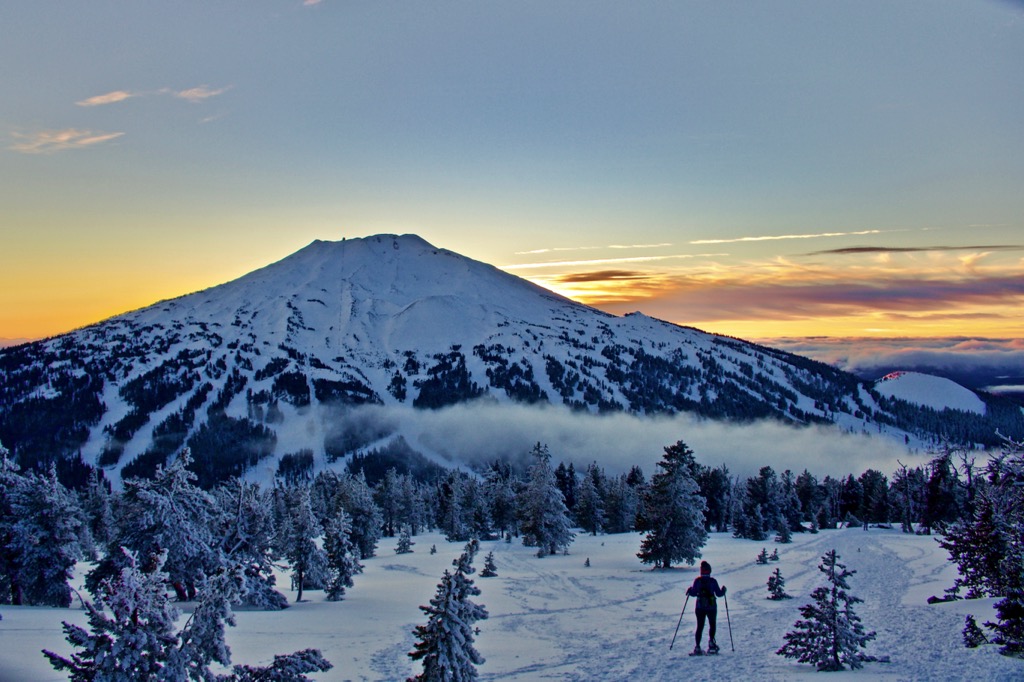Get PeakVisor App
Sign In
Search by GPS coordinates
- Latitude
- ° ' ''
- Longitude
- ° ' ''
- Units of Length
- Temperature

Yes
Cancel
Share ×

Scan the QR code and open PeakVisor on your phone
❤ Wishlist ×
Choose
Delete
Mt. Bachelor is the largest of the northwestern US state of Oregon’s dozen ski resorts. It boasts 4,323 skiable acres (1,750 hectares), making it the fifth and sixth-biggest in the US and North America, respectively. The resort's main feature is Mt. Bachelor (9,065 ft / 2,763 m), one of the impressive conical volcanic peaks of the Cascade Range. But what sets the resort apart is that you can ski 360 degrees off the summit and chase conditions across all aspects. On top of this, it’s home to some of the best tree skiing in the country. One hundred and one named runs total more than 62 mi (100 km), mostly of intermediate and advanced difficulty. The resort operates 12 ski lifts, including eight high-speed quads. The Mt. Bachelor ski season is generally from late November to late May.
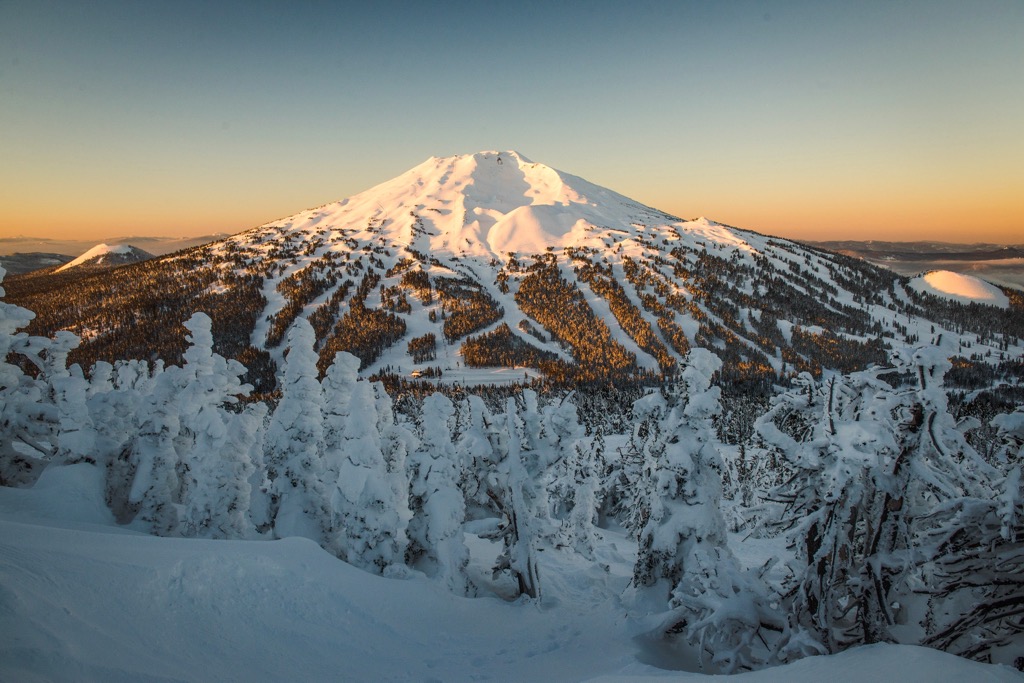
Mt. Bachelor Ski Resort is part of an imposing wall of volcanic peaks that separates eastern Oregon from the coast of the Pacific Ocean. These charismatic volcanoes are known for being visible from incredible distances. The range includes other giants like Mt. Saint Helens (8,362 ft / 2,549 m), known for its 1980 eruption, and Mt. Hood (11,250 ft / 3,429 m).
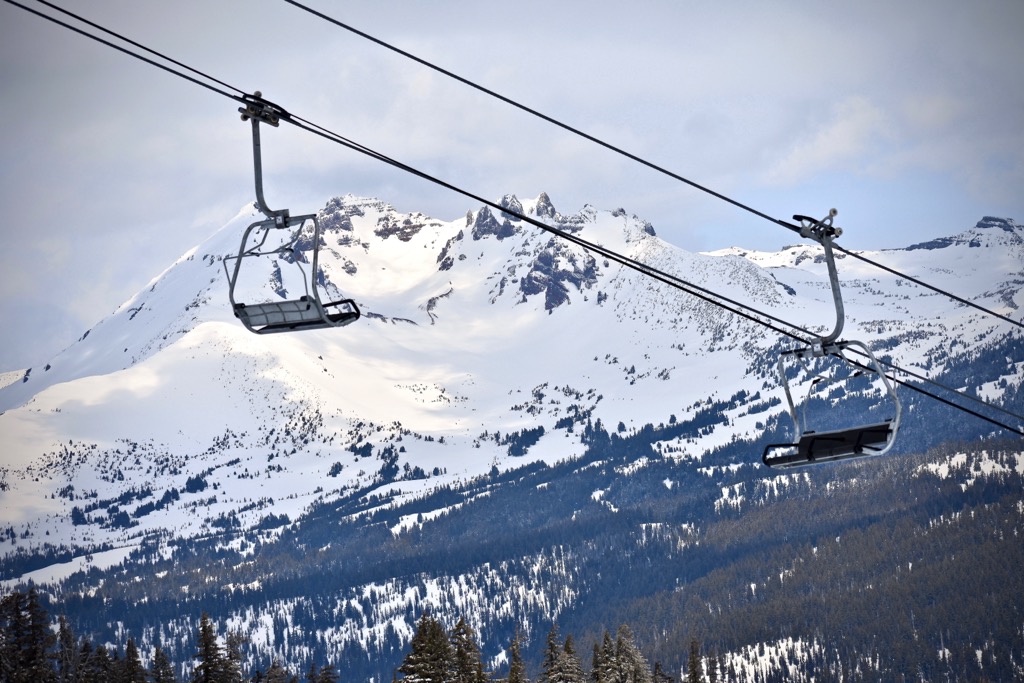
The US Forest Service manages the resort’s land; specifically, it is part of Deschutes National Forest, Bend-Fort Rock Ranger District. This area is well-known as one of the final legs of the PCT (Pacific Crest Trail), an overland trek from the US-Mexico border in California to the US - Canada border in Washington.
The Cascade Range creates a boundary between the arid, high desert badlands to the east and the temperate rainforest to the west. The area's relief is breathtaking; from the summit of Mt. Bachelor, you can easily spot peaks more than 100 mi (161 km) away on the Washington state border.
The nearest city to Mt. Bachelor is Bend, Oregon, which lies roughly 21 mi (34 km) to the east. Bend is a very accessible city, just three hours south of Portland and two hours west of Eugene.
The nearest airport is Redmond Airport, located 16 mi (26 km) northeast. Redmond features regular flights from Portland, Seattle, Salt Lake City, Los Angeles, and Denver. The airport is a great way to get to and from Bend for tourists who want to fly in for a short period.
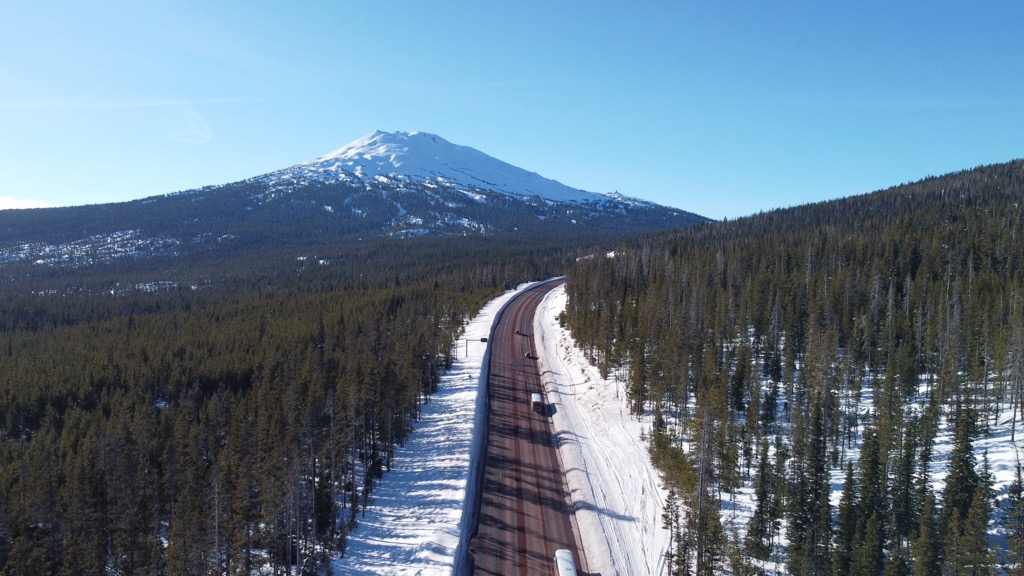
However, getting from Bend to Mt. Bachelor is slightly more complicated. The one road to and from Mt. Bachelor is the Cascade Lake National Scenic Byway (also known as the Century Drive). This stretch of road is long, winding, steep, and dangerous in the winter. Century Drive often sports a thick coat of snow or black ice during the winter.
Mt. Bachelor Resort operates a mountain shuttle that picks up in Bend every half hour. Skiers can purchase a round-trip to and from the mountain for $12, taking the stress out of driving on powder days.
Another perk of skiing at Mt. Bachelor Ski Resort is the extended season. Snowfall starts very early in the Cascades, while the winter’s accumulated snow lasts well into the spring. The mountain’s lifts start turning on November 30th every year. The closing date depends on snowpack but can be anywhere from April 24th to May 28th. Usually, closing day is sometime in mid-May.
Whereas most resorts close around the beginning of April, Mt. Bachelor commonly offers an extra one or two months of skiing. Even after the lifts close, locals often hike to the peak's summit and ski the leftover snow, which can last until August or even later.
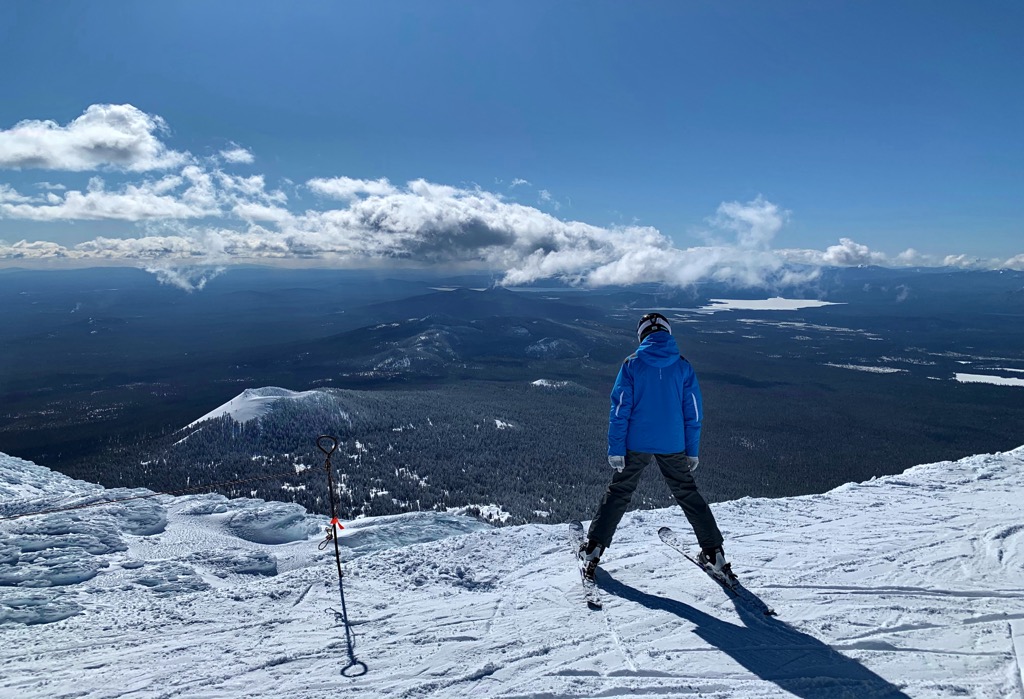
The Cascades are known far and wide for their extreme weather; the conditions greeting you on any given day at Mt. Bachelor are a total crapshoot. Driving winds at the summit have reached 200 mph (321 kph). In addition, impenetrable fog and rime ice frequently engulf the mountain. It’s relatively common for Mt. Bachelor to receive 48 inches (122 cm) of snow in a day or two. After all, the resort averages 462 inches (1,173 cm) of snow per year. However, rain can fall due to these storms’ coastal influence, especially at the base.
But bluebird powder days are also standard. The resort gets more sun than its counterparts closer to the coast; here, a bit more continental influence can bring dry air and blue sky.
As for the snow itself, it ranges as much as the weather:
Lovers of spring skiing will be enamored with Mt. Bachelor Ski Resort. As the days grow longer and the Summit lift stays open, skiers can follow the sun from one side of the mountain, ensuring perfect turns all day.
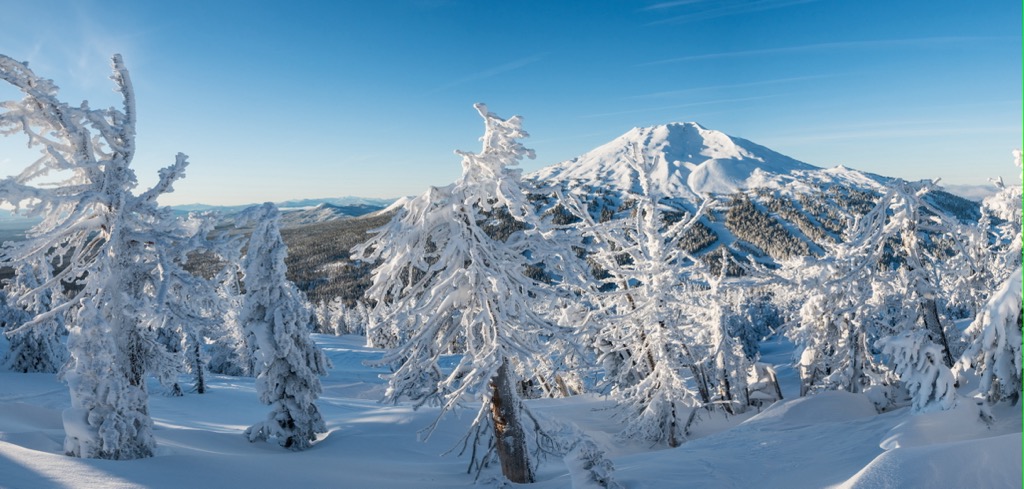
Sunrise Base Area and West Village Base Area serve the entire ‘front side,’ sitting on the mountain's northeast aspect. The resort’s summit and backside are accessible only by the Summit Lift, Mt. Bachelor’s only mid-mountain lift. Most skiers drive to the main lot, which is the furthest. This base area grants access to Little Pine, Pine Marten, and Red Chair Lifts. Little Pine is a beginner lift that accesses just beginner runs.
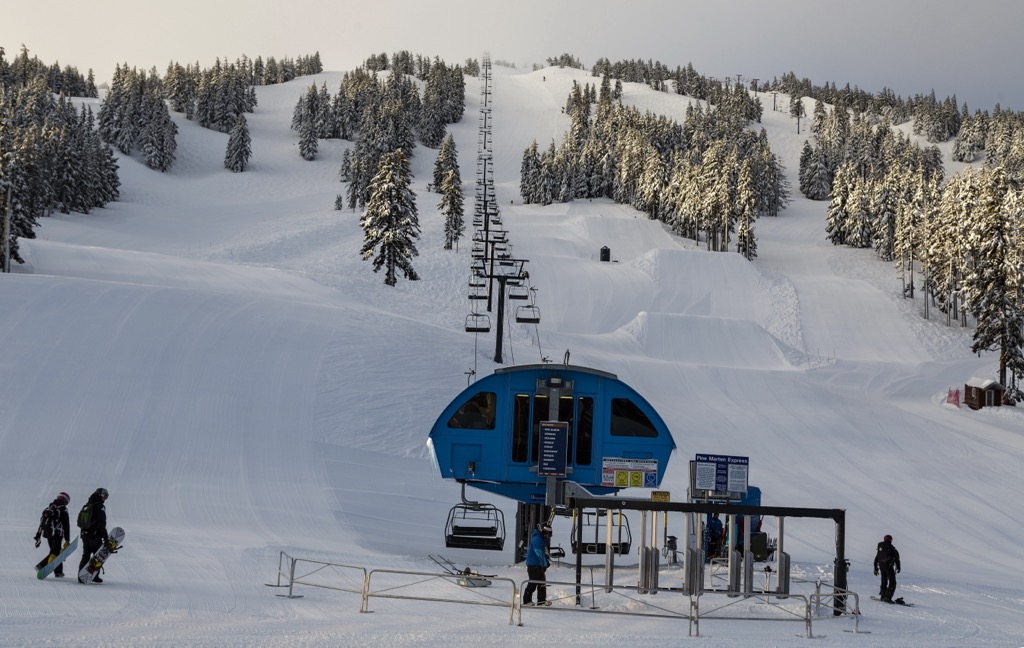
There are a total of 12 chairlifts at Mt. Bachelor. These include eight high-speed quads, a fixed-grip quad, and three fixed-grip triples.
Mt. Bachelor is a mountain with a thousand moods, and every lift on its face perfectly fits one of those moods. There are spots for stormy days, calm spots for when the winds howl, dramatic, open slopes to hit when the sun shines, and tons of room to spread out once t-shirt weather starts.
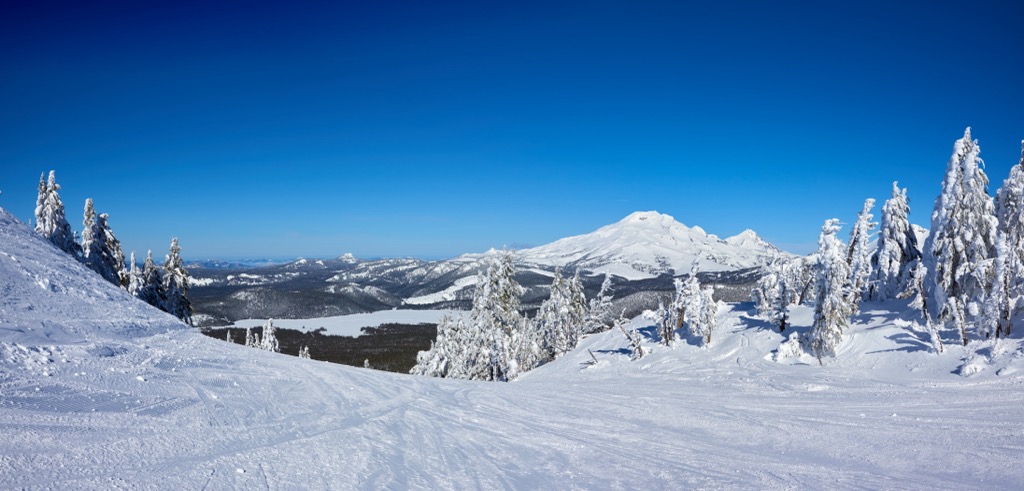
Pine Marten Lift is a high-speed quad that drops skiers off at the Pine Marten Lodge. The slopes below Pine Marten are inclusive to most ability levels, ranging from green to black. There are short, steep pitches midway down the mountain and lots of little glades to crash through.
From the top of Pine Marten, skiers can traverse to the bottom of just about any lift on the mountain, including the north side, where Outback and Northwest are located. Skiers can also head to Outback and Northwest from Red Chair, but it’s usually only open on weekends and powder days.
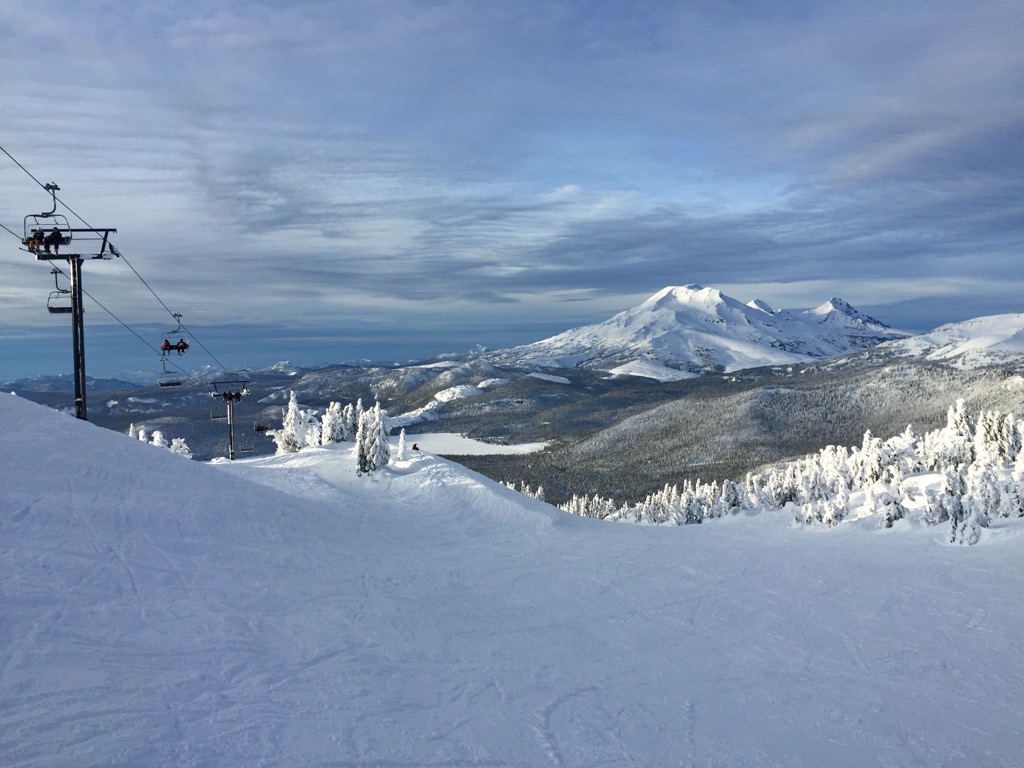
Experienced skiers usually hop directly on Pine Marten or Red Chair and head for Outback on a day with a lot of fresh snow. The Outback lift accesses blue and black runs and features dreamy tree skiing. But if you traverse further from Pine Marten Lodge, you can also get to Northwest.
Northwest Lift is where local experts hang out on powder days and when the Summit Lift is closed. This lift is truly something to behold, covering over 1.5 mi (2.4 km). It also gains 2,336 ft (712 m) of elevation, the 8th most vertical covered by a chairlift in North America.
It’s so long that the top shack is above the treeline. Following the lift towers back down to the bottom, you can witness all of Mt. Bachelor’s moods: windswept, treeless gullies, snow ghosts standing like icy columns, and finally, forests of giant hemlock trees. It’s hard to beat Northwest’s terrain on a fluffy powder day.
But the northwestern aspect of the mountain is sometimes heavily socked in by clouds and fog. On days like this, it’s wise to go in the opposite direction and head toward Cloudchaser.
It’s best to start from the Skyliner or Sunrise parking lots to reach the ski area’s far left side. Hop on the Skyliner or Sunrise Lift, then traverse skiers’ right. Heading to Cloudchaser from Skyliner, you’ll pass the Summit Lift.
There is a lot of ground between the middle mountain and Cloudchaser. There are many freestyle parks, sparse trees, and a lot of the mountain’s green and blue runs. As you get closer to the “Cloud,” the slopes get steeper.
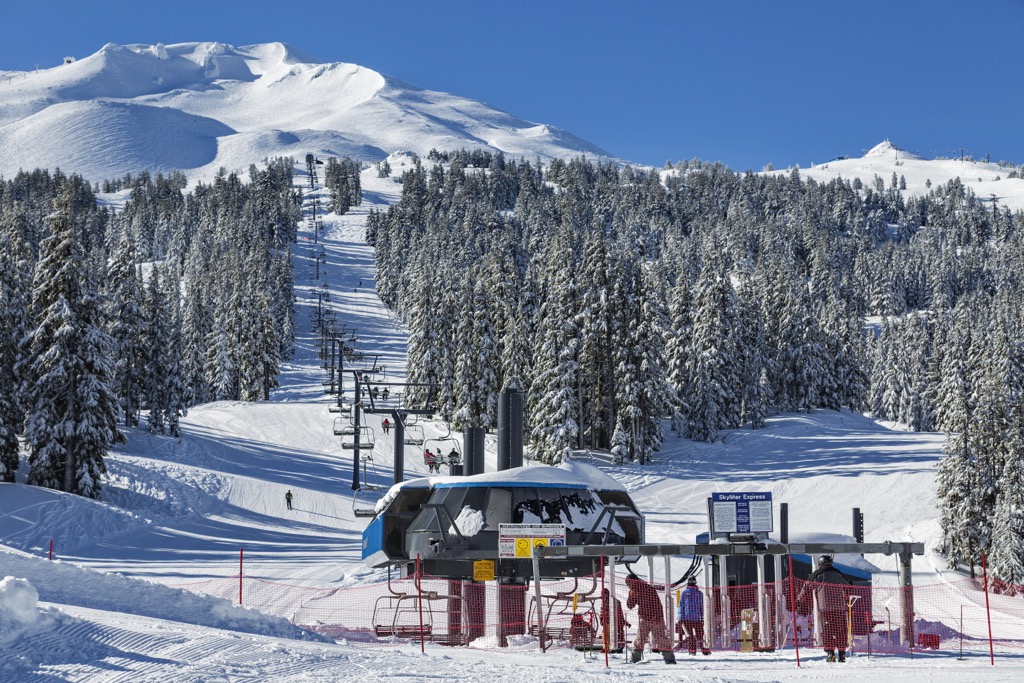
The Cloudchaser is a long, less steep lift that covers a ton of terrain. Almost all of this map area is accessible only from Cloud or the Summit. This side of the mountain is known for having some excellent tree skiing and good powder conditions.
The slope angle is much more gradual and accessible than the Outback / Northwest side of the resort, and it’s a lot more suitable for intermediate skiers. There are a ton of natural features here, too. Swooping between trees, through natural half pipes, and over rollers is what Cloud is all about.
But what about when the powder season is over, the sun shines bright, and the snow turns to corn? The mid-mountain and the Summit are the places to be in the late season.
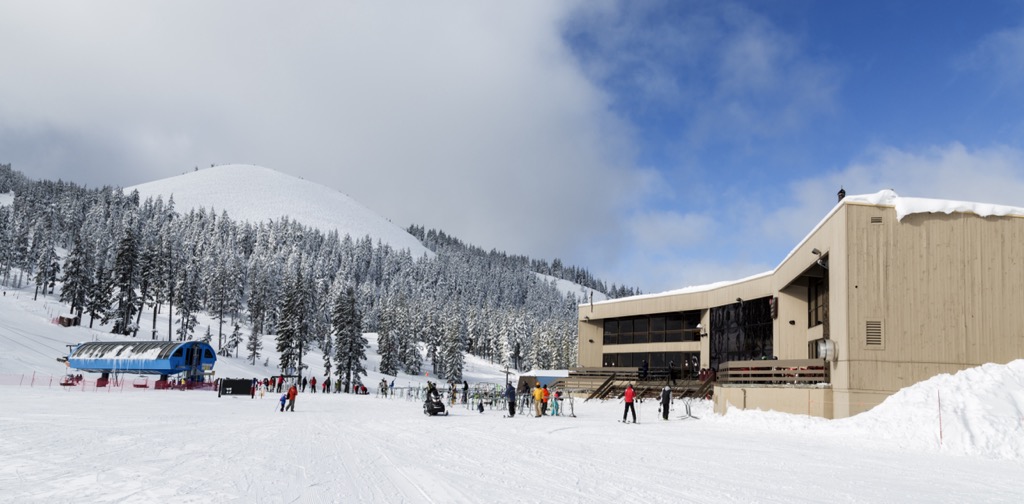
Although Mt. Bachelor Ski Resort has a massive backside, it’s often not accessible for skiers. The Summit Lift doesn’t run during high wind, which is common in midwinter. But on bluebird days, especially in the spring, there is no better place to be than on the Summit Lift.
From the summit, you can ski a full 360 degrees. The back bowls are a wilderness of expert-only terrain. Skiing from the top down the back side and returning to the base area, you can ski 4 mi (6.4 km) in a single run! Because it’s so vast, you’ll never take the same line twice down the back side. You can also access the Cirque Bowl from the Summit Lift, featuring Mt. Bachelor Ski Resort’s steepest steeps and tightest turns.
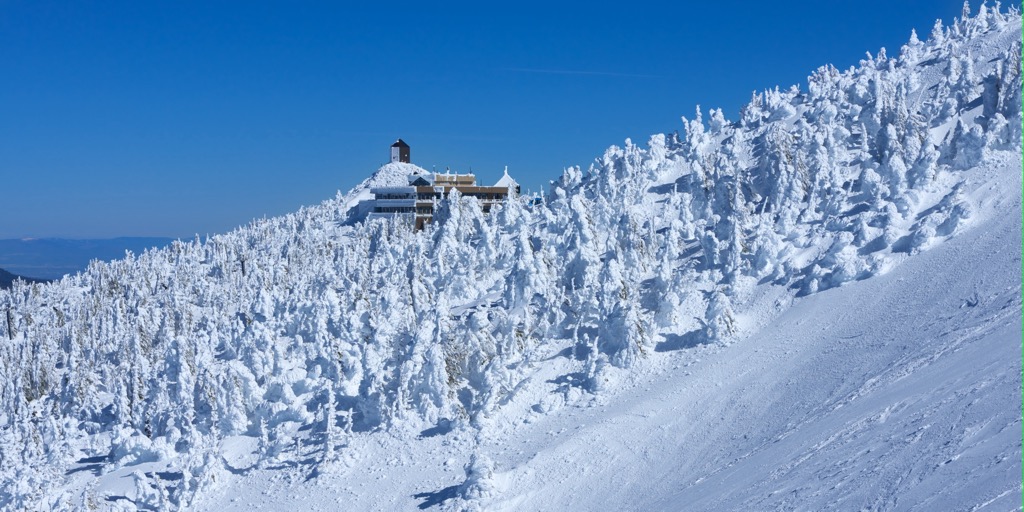
Skyliner is the best lift for park rats at Mt. Bachelor Ski Resort. It gives access to the mountain’s largest freestyle terrain park. Park features include a competition-size half pipe, a performance venue, and sometimes a wave park under the Pine Marten Lift. If it’s too crowded, you can head to Sunrise or Rainbow and check out the smaller parks.
Describing Mt. Bachelor Ski Resort from a distance is easy. Its profile resembles an almost symmetrical cone thanks to its main feature, Mt. Bachelor, an impressively conical peak that tops out just above 9,065 ft (2,763 m).
But what sets the resort apart is that you can ski 360 degrees off the summit. So when the snow is not ideal on one side, you can just move to the other and ski in different conditions. The far side will usually be clear when one side is socked in and stormy with poor visibility. When the powder is too wet on the west side, it’s light and fluffy on the east side. Finally, in the warm months, skiers can follow the sun to ski perfect corn all day.
On top of this, it’s also home to some of the best in-bounds tree skiing in the country. The backside of the mountain features a well-spaced forest, and on good days you can ski 3,300 ft (1,006 m) of vertical over four miles (6 km) from top to bottom, all without crossing another skier’s tracks.
But up close, there is a lot of variation in its terrain:
Ridges and gullies. The most prominent terrain features here are the ridges and gullies running parallel from the summit to the base. These ridges form natural half-pipes and wind lips, an absolute joy to play on. There are many naturally-formed jumps of all sizes around the mountain, and it’s easy to leapfrog from top to bottom over natural features.
Cirque Bowl and Cindercone. These are two prominent features on Mt. Bachelor:
The resort itself rises over 3,300 ft (1,005 m), from 5,700 ft (1737 m) at the base of the Northwest Lift to a summit elevation of just over 9,000 ft (2,743 m). The maximum vertical drop is 3,366 ft (1,026 m).
Tree skiing. Dense forests of giant hemlock trees cover the lower two-thirds of the mountain. These trees give much of the Pacific Northwest its signature look but are also the mountain’s most significant hazard. Read up on tree well danger before going off-piste at Bachelor. Every year, at least one person dies in a tree well in the PNW.
Criss-crossing through the forest of conifers is a maze of runs and glades. Most lifts and named runs at Mt. Bachelor are on its northern face. The backside, accessible only by the Summit Lift, has no groomed runs, except a few traverses that lead around the peak back to the base area. The back side is home to the resort’s steepest slopes and a paradise for tree skiing aficionados.
As you climb higher on the mountain’s flanks, the trees thin. Those that grow higher on the peak spend most of the winter covered in a thick layer of hoarfrost. These stooped, frozen trees are often called “snow ghosts.” At around 7,775 ft (2,370 m) elevation, the height of the Pine Marten Lodge, the trees abruptly stop.
The terrain above treeline. In the absence of trees, the experience of riding Mt. Bachelor changes dramatically. The effects of wind become more apparent. Wind lips grow to obscene sizes, sometimes forming deep cups and steep, angular shapes taller than a person. The wind is a primary factor of conditions that change day-to-day or even hour-to-hour. But the same is true of tree skiing at Mt. Bachelor. Tree features are ephemeral and will sometimes disappear or change after a season. After all, Mt. Bachelor is a new mountain created by volcanic activity. It is a growing, changing landscape from the bedrock to the trees that dot its surface.
Here is a summary of all the slopes, ski lifts, and other skiing-related features and services of the Mt. Bachelor Ski Resort:
Slopes
Ski lifts
Other features and services

Mt. Bachelor does a great job of accommodating all kinds of snow sports. The resort includes a Nordic lodge, found at the Mountain Gateway lot. The lodge services a colossal network of Nordic trails for cross-country skiers of all ability levels, including green, blue, and black runs.
The Nordic trails at Mt. Bachelor Ski Resort stretch around the mountain's north or Back Side. In particular, it offers 22 groomed trails for classic and skate-style skiing, the longest of which is Oli's Alley (7 mi / 12 km), of 38 mi (56 km) in total.
The resort also has the most extended season for groomed Nordic skiing in North America, from late November through May.
The trail area also includes several signed and packed snowshoe trails of 6 mi (10 km) for those who prefer to adventure one step at a time.
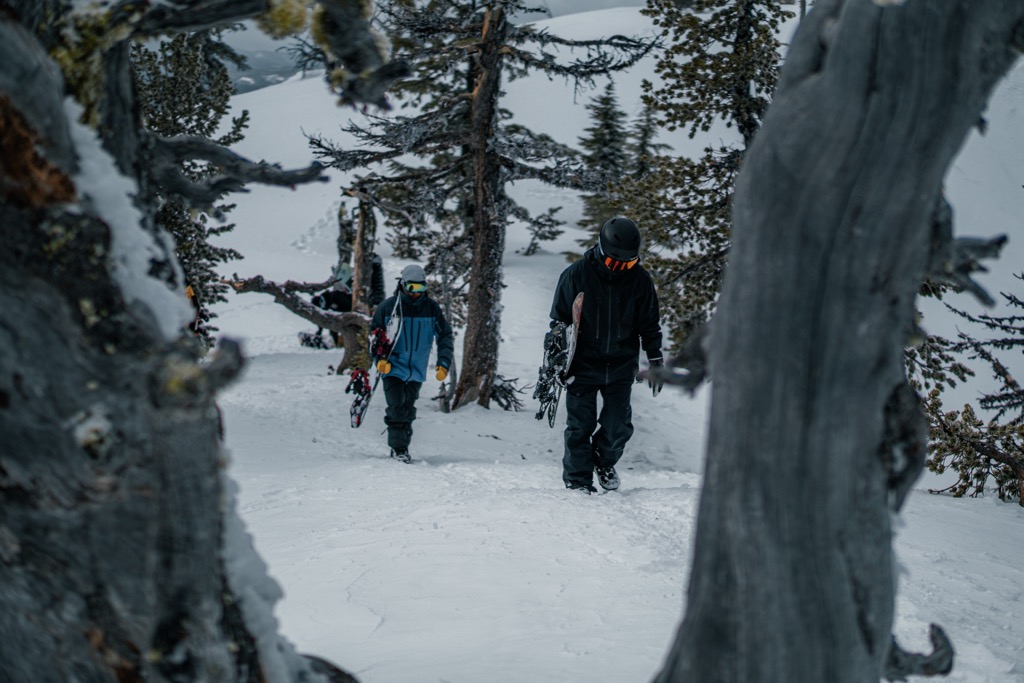
Uphill travel or ski touring is also welcome at Mt. Bachelor.
The uphill route consists of three legs, beginning at the Mountain Gateway lot. The first leg ascends around the south side of the cone. Many backcountry skiers will climb the cone and ski back down the south side.
But you can also continue following uphill travel signs to the Pine Marten Lodge. The second leg of the tour requires a lot of attention and awareness. Once you get above the cone, you’re not on the resort boundary but between runs. Follow signs and stick to the looker’s right to avoid collisions.
Above Pine Marten Lodge, you should almost be able to see the summit. But you’ll still have to climb another 1,000 ft (304 m). Again, the uphill route is marked by signs. Follow them. You can take this route up the north ridge of the Cirque Bowl to the summit, giving you a buffet of options for skiing back down.
Be aware that there are restrictions on when you can go uphill at Mt. Bachelor. The resort’s current conditions page at its official site has more info on uphill conditions and daily closures on the different sections of the uphill route.

Compared to other major ski destinations in the US, like Utah, Colorado, and Wyoming, skiing in Oregon is very affordable. Lift tickets range from $103 to $143 in the peak season. Buying in advance guarantees that you save at least $25.
Multi-day passes also offer additional savings. Buying a multi-day pass in advance can save as much as 40%, compared to buying tickets same-day at the ticketing window. The resort also offers beginner passes for new skiers using learning areas only.
The Ikon Pass ($1299 adult with $999 renewal) allows for seven days, and the Ikon Base Pass ($919 adult with $739 renewal) provides five. If you only use your days at Mt. Bachelor and no days at other resorts, the Ikon offers little savings over buying day or multi-day passes.
However, the Ikon Pass is an incredible deal because you can access over 50 resorts across North America. Even if you use all of your days at Bachelor, you can still visit many of the best ski resorts on the continent. More than a dozen resorts have unlimited access — the Ikon Pass is their season pass. Ikon Pass holders may receive other benefits, including a 25% family and friends discount on day passes and a discount on food, lodging, and retail (varies depending on the location).
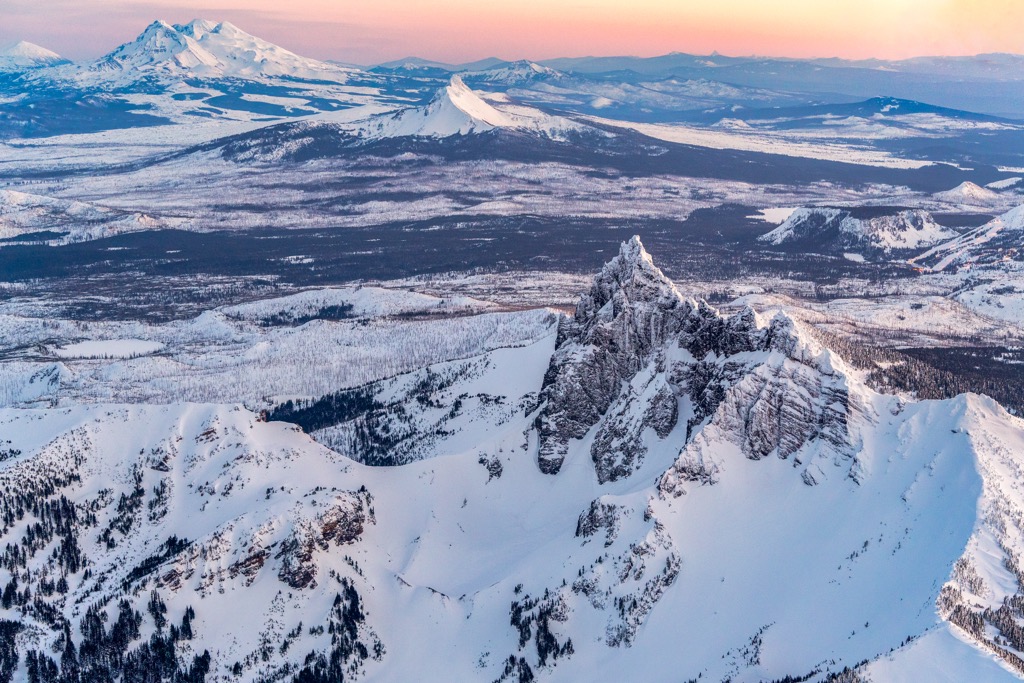
On your way to or from Mt. Bachelor Ski Resort, visit the official Bend tourist office to learn more about the resort, the town itself, and the entire state of Oregon. At the center, you can pick up a paper map as a keepsake, buy souvenirs, ask for advice, and chat with the local staff.
Bend Visitor Center
750 NW Lava Road, Suite 160, Bend, OR, 97703, USA
Monday to Saturday: 10 am to 4 pm, Sunday: closed
8772458484 (toll-free), 5413828048 (local)
Mt. Bachelor Ski Resort features three full-service lodges with solid options for food and libations. The Sunrise Lodge, West Village Lodge, and Pine Marten Lodge each have a restaurant, bar, and cafe.
The Sunrise Grill is a solid all-ages option from the base of Sunrise Lift. The menu offers burgers, sandwiches, salads, and other lunch options.
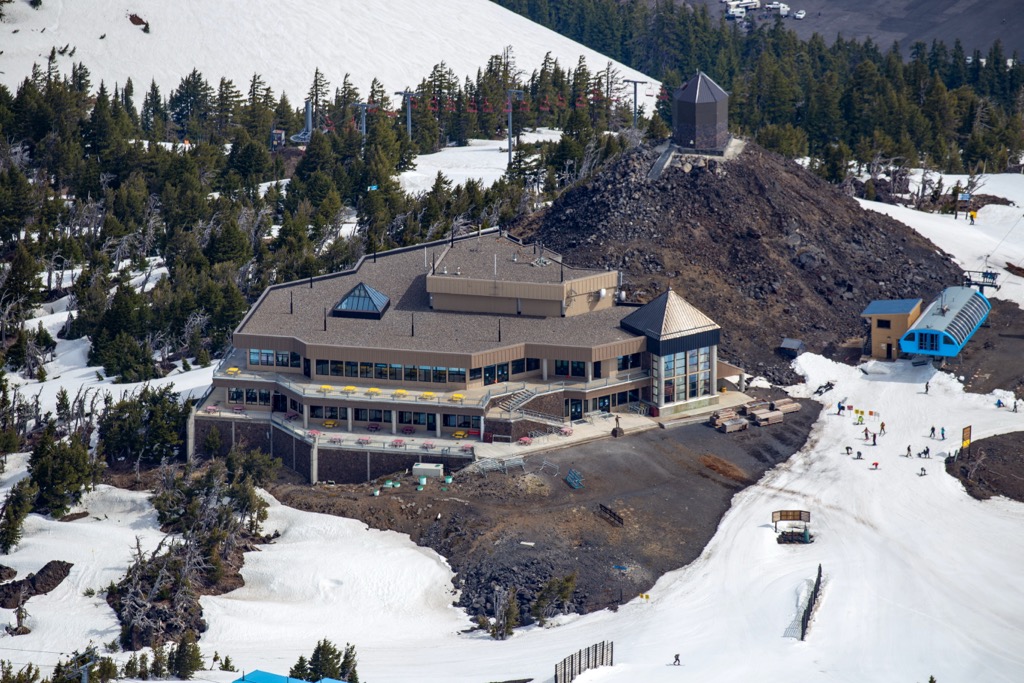
Cocoa’s Cafe & Corner Bar is open for breakfast and lunch in the West Village Lodge. It’s an excellent spot to stop for a quick on-the-go bite.
There are few better feelings than dining in a mid-mountain lodge during a snowstorm. Scapolo’s is the top choice for dining at Mt. Bachelor, with Mediterranean-inspired dishes and American fare. Spark’s Cafe is another option in Pine Marten Lodge, serving up American and Mexican food.
Events are frequent and a ton of fun at Mt. Bachelor. Every year, a new set of slopestyle competitions and rail jams are hosted in the park under Pine Marten Lift. But there are also family-friendly concerts, pop-ups with local breweries like 10 Barrel, and uphill races like VertFest.
You won’t find a more beer-friendly culture than Central Oregon. Bend is known far and wide for its eclectic breweries, especially the quality of the hop-forward IPA they produce. Mt. Bachelor has a bar in just about every lodge on the mountain.
The views don’t get much better than at the Pine Marten Lodge. Sparks Cafe has a full bar with an excellent selection of microbrews, cocktails, and wine. And from 7,775 ft (2,370 m), you can see for hundreds of miles (kilometers). Popping in for a quick beer on a sunny afternoon is pretty unbeatable.
The Sun Bar, located at the Sunrise Lodge, is the best open-air patio setting on the mountain. It’s a full outdoor bar with shading and heaters, not to mention a full selection of local beer on tap.
The best spot at the end of the day is the Clearing Rock Bar in West Village. It’s open until an hour after the last chair and has the best local beer, wine, and craft liquor selection from Central Oregon.
